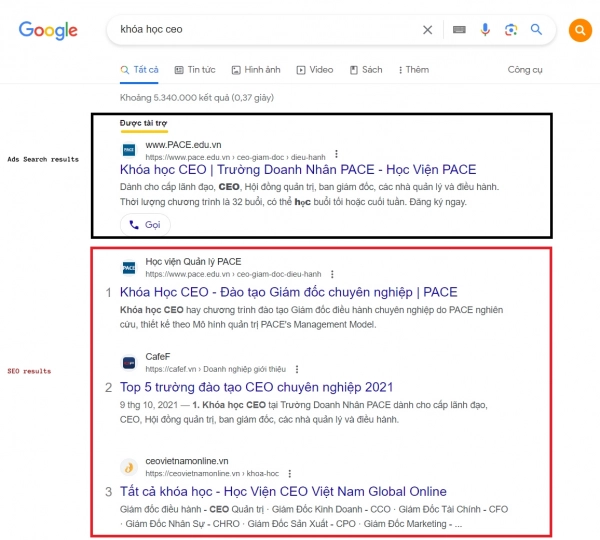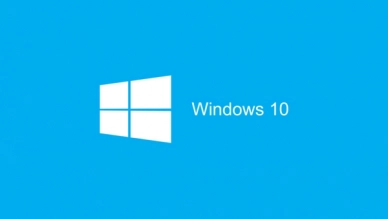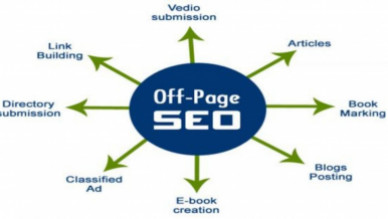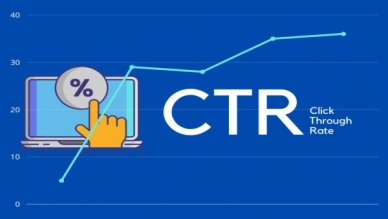What is SEO? Overview of SEO
Every day, users perform billions of searches for information, products, and services. To leverage the potential of this traffic, businesses need to ensure their content appears in the top natural search results for their target keywords. This process is known as SEO.
What is SEO?
SEO stands for Search Engine Optimization. It is the process of improving and optimizing a website to make it more suitable for search engines, helping the site rank higher in search results on engines like Google, Bing, Yahoo Search, and Cốc Cốc. SEO activities include optimizing page load speed, building a website structure, creating a network of links, and most importantly, producing helpful, reliable, people-first content.
In marketing, SEO is a component of SEM (Search Engine Marketing) – meaning marketing through search engines. Additionally, SEO refers to the job title "Search Engine Optimization Specialist."
The main goal of SEO is to improve a website's ranking in search results, get a high ranking in Google's SERPs, increase traffic, and enhance brand credibility. This, in turn, attracts potential customers and boosts revenue in the digital environment.
Because most users use Google, when people refer to SEO, they typically mean SEO on Google. Effective SEO aims to be in the top 10 natural positions, which is different from paid "Ad" results. As illustrated below, the black box indicates Ad results, and the red box indicates SEO results:

How Google Search SEO Works
Google, the most popular search engine, operates in three basic stages:
1. Crawling
Google uses data collection tools (Google bots) to find new and updated web pages, storing their URLs in a large list. Google discovers web pages primarily through links from known websites.
Googlebot is a general term for Google's two types of web crawlers:
- Googlebot Smartphone
- Googlebot Desktop
2. Indexing
Google uses automated programs called crawlers to download text, images, and videos from known web pages. Google then analyzes these files to understand the content of the web pages. This information is stored in Google's Index, a massive database on many computers.
3. Providing Search Results
When users search on Google, Google tries to determine the highest quality results based on various factors such as user location, language, device (computer or phone), and previous search queries. For example, a search for "bike repair shop" will yield different answers for users in Paris and Hong Kong. Google does not accept payment to rank pages higher. The ranking is done by algorithms.
Google uses different factors to determine the most relevant search results for users, including location, language, device, and previous search terms. For example, if a user in Vietnam searches for "bike repair shop," Google will show the most relevant results based on the user's location. Google does not accept money to increase page ranking; the ranking is purely algorithmic.
Other search engines like Bing, Yahoo, Yandex, and Cốc Cốc have different algorithms to determine the best search results for users.
The Role of SEO Today
1. Sales Opportunity
A well-optimized website for search engines like Google, Bing, Yahoo, and Cốc Cốc is more likely to appear in higher natural search results. This increases the chance of attracting high-conversion potential traffic. It also builds trust and credibility for the business, as users tend to trust and choose websites appearing at the top of search results. Optimizing SEO can help attract potential customers and create sales opportunities.
SEO also improves user experience on the website. Optimized websites usually have faster load times, easier-to-read and navigate structures, and valuable content, increasing the conversion rate from visitors to customers.
2. Brand Awareness
When users search for industry-related terms, products, or services that a business offers, appearing near the top of search results creates a positive impression and increases the likelihood of users clicking on the website. This helps build brand awareness and attract traffic that can convert into potential customers.
Using brand-related keywords in the SEO strategy strengthens the association between the brand and those keywords. When users consistently see the brand in search results, they remember and recognize it more, building long-term brand trust and awareness.
3. Brand Trust
SEO helps a business's website appear at the top of search engine results, indicating expertise and providing valuable information to customers. High rankings and positive reviews create trust and reputation with customers, enhancing brand value and encouraging repeat visits.
4. Cost Optimization
SEO helps a business's website appear higher in natural search results (SERPs), attracting potential customers without paying for ads. This saves significant marketing costs. SEO is a natural marketing form that doesn't require direct advertising costs like Google AdWords or social media ads. Once a business achieves high search engine rankings, it can continue to attract substantial traffic without ongoing ad expenses.
5. Retargeting
SEO helps websites rank higher on search engines, making it easier for potential customers to find the business when searching for related products or services. Businesses can implement remarketing strategies through SEO, targeting customers who visit the website and fall into the customer journey funnel.
6. Marketing Measurement
SEO is a tool of online marketing, capable of measuring effectiveness. SEO metrics can be divided into result metrics and process metrics. Result metrics include keyword ranking, traffic, conversion rate, and revenue, measured using tools like Google Analytics and Google Search Console. Process metrics include domain age, website speed, backlinks, time on site, and bounce rate, also measured with tools like Google Analytics and Ahrefs.
7. Long-term Business Strategy
SEO improves a website's position in natural search results, allowing businesses to reach more potential customers. A high-ranking website in search results is seen as more credible and trustworthy. Appearing alongside major brands in the industry helps build the business's brand.
Continuous optimization and quality improvement of the website, especially by publishing high-quality and optimized content, lead to stable and sustainable SEO effectiveness. When a sales page achieves a top position and the content convinces customers to buy, the page will continue to generate value and orders for the business over months and years. All value created through SEO accumulates and persists throughout the website's operation. The website must meet user needs, provide valuable content, and be easy to use, increasing the conversion rate from visitors to customers.
SEO Challenges
1. Long Implementation Time Affecting Business Opportunities
An effective SEO campaign requires a long time to build and implement. It involves keyword research, content optimization, link building, and monitoring results, which can be time-consuming and demand patience. The extensive effort and resources needed for SEO optimization may divert focus from other business activities such as product development, communications, marketing, and customer relationship building.
2. Landing-Page SEO
Ensuring that landing pages meet Google’s requirements and standards is crucial. Search engines like Google use complex algorithms to determine rankings and display search results. If a website does not follow Google's guidelines and standards, it may be limited or not ranked high in search results.
3. Increasing Competition
Competition is an inherent part of business. When competitors improve their SEO strategies, they are more likely to rank higher for targeted keywords, which can impede traffic from organic searches. Therefore, a business's marketing team needs to stay updated, refresh content, and enhance search rankings to create real value for users.
4. SEO Alone Does Not Guarantee Conversions
SEO is vital for increasing a website's conversion rate, but relying solely on SEO is insufficient. To drive conversions, businesses should also focus on other complementary factors such as:
- Improving User Experience (UX/UI): The website should be user-friendly, easy to navigate, and meet customer needs.
- Creating Quality Content: Website content should be useful, engaging, and attractive to customers.
- Running Remarketing Campaigns: Reaching out to customers who have previously visited the website.
- Nurturing Potential Customers: Building a CRM system to track and care for potential customers.
To achieve optimal results, businesses need to develop two parallel plans:
- Customer Attraction Plan: Attract potential customers to the website through channels such as SEO, advertising, PR, etc.
- Conversion Optimization Plan: Convert potential customers into actual customers, generating revenue.
5. Constantly Changing Google Algorithms
Google frequently updates its algorithms to improve search results and prevent improper search engine optimization. Some algorithm changes can significantly impact a website's traffic and sales, which can be concerning for SEO practitioners.
Therefore, SEO professionals should not solely focus on optimization but also prioritize user experience. The ultimate goal of search engines is to provide the best and most relevant results to users. Algorithm changes also offer opportunities for websites that adhere to best practices and provide quality content to stand out in search results. SEO experts can study new algorithm changes, understand the influencing factors, and adjust optimization strategies to meet Google’s requirements.
Popular SEO Types Today
1. Comprehensive SEO
Comprehensive SEO is a holistic strategy focused on improving a website's ranking on search engine result pages (SERPs) for multiple keywords and related phrases. This strategy includes optimizing both on-page and off-page factors of the website.
2. Keyword SEO
Keyword SEO involves optimizing a website based on target keywords according to the standards of Google or other search engines like Cốc Cốc, Bing, Yahoo, etc. The ultimate goal is to get the keywords to appear on the first page of search results.
Keywords are the words or phrases people use to search for information on search engines. When a user enters a keyword in the search bar, Google displays the most relevant search results for that keyword. Optimizing for keywords helps a business's website appear higher in search results, attracting more visitors.
3. Image SEO
Image SEO involves optimizing images on a website to help them display better in search engine image results. This includes selecting high-quality images, optimizing image names and alt text, using meta tags, and optimizing image size and load time.
4. Video SEO
Video SEO is the process of optimizing video formats on platforms such as YouTube, websites, and social media to rank higher in search results on engines like Google, Bing, Yahoo, etc. Like web SEO, video SEO employs techniques to improve video rankings in search results, increasing viewership.
5. Local SEO
Local SEO is the process of optimizing a website and business profile to rank higher in local search results (SERPs). This helps potential customers find the business when they search for related products or services in their area. Local SEO, often understood as SEO Maps, is commonly used by restaurant, hotel, and other local business websites.
6. Mobile App SEO
Mobile app SEO involves optimizing mobile applications to rank higher in app store search results, such as App Store, Google Play, Microsoft Store, Windows Store, etc. Mobile app SEO is a crucial part of an app's marketing strategy, helping the app be discovered and downloaded by more users.
7. E-commerce Platform SEO
E-commerce platform SEO is the process of optimizing search engines for storefronts on e-commerce platforms like Shopee, Lazada, Tiki, etc. The goal is to help products rank high in the platform's search results, attracting more potential customers and increasing sales.
Google's Algorithm Impact on SEO
1. Panda Algorithm
The Panda algorithm is designed to penalize websites with low-quality content. Sites with duplicate content, spelling errors, or content that provides little value to users may be ranked lower or even removed from search results.
2. Penguin Algorithm
The Penguin algorithm aims to penalize websites that use black-hat SEO techniques to boost their rankings. Black-hat SEO techniques include unnatural link building, keyword stuffing, or using spammy tactics.
3. Hummingbird Algorithm
Named after the hummingbird, known for its quick and precise flight, the Hummingbird algorithm is designed to better understand user intent and return more relevant search results. It uses factors like semantics, context, and relevance to evaluate a website's quality. This means Google ranks sites higher if they provide information that aligns with the user's intent.
4. Pirate Algorithm
Google's Pirate algorithm is developed to combat websites that steal copyrighted content. It uses machine learning techniques to detect websites with copyright-infringing content that have been frequently reported.
5. Pigeon Algorithm
The Pigeon algorithm, introduced by Google in 2014, is a local search algorithm that aims to improve local search results by using geographical factors to rank websites. Before this algorithm, local search results were often inaccurate and not relevant to users' needs. Pigeon has made local search results more precise and useful.
6. Mobile-Friendly Algorithm
The Mobile-Friendly algorithm is designed to evaluate a website's compatibility on mobile devices (tablets, iPads, or smartphones). With the increasing number of mobile users, businesses must optimize their websites for mobile devices.
7. RankBrain
RankBrain uses machine learning to understand user intent behind each search query. It analyzes factors such as keywords, user location, search history, and other elements to determine the most relevant search results. RankBrain is one of the most critical factors in Google's search algorithm, helping to provide more relevant search results, even for new or ambiguous queries.
8. Possum Algorithm
The Possum algorithm is used by Google to handle websites with duplicate or similar content, aiming to improve search result quality by minimizing the number of duplicate sites appearing in the results. It analyzes sites based on content, structure, and links, lowering the rank of those with duplicate or similar content.
Common SEO Approaches
1. White Hat SEO
White Hat SEO follows the rules and recommendations of search engines. These methods focus on creating quality content, optimizing the site, and building natural links. White Hat SEO is a safe, sustainable approach recommended by SEO experts. Key techniques include:
- Creating high-quality, useful, and relevant content for the target audience.
- Optimizing the website for keywords and phrases the business wants to rank for.
- Building quality links from reputable websites.
- Improving website technical aspects for better speed and usability.
- Adhering to search engine guidelines.
- Providing sustainable results.
- Requires time and effort to implement.
2. Black Hat SEO
Black Hat SEO uses unorthodox or even fraudulent methods to improve site rankings, such as keyword stuffing, spammy link building, and using technical tricks to deceive search engines. This approach can yield quick results but is risky, as Google can detect and penalize it, damaging the site's reputation. Notable techniques include:
- Keyword stuffing: Overusing keywords in the content, making it hard to read and unnatural.
- Creating fake links: Buying or creating links from unrelated or low-quality sites.
- Hidden content: Using CSS or JavaScript to hide content from users but showing it to search engines.
- Duplicate content: Copying content from other sites and using it on one's own.
- Manipulating algorithms: Exploiting search engine algorithm loopholes.
3. Grey Hat SEO
Grey Hat SEO falls between White Hat and Black Hat SEO. These techniques may be legal but can pose risks to the site. Grey Hat techniques often don't fully comply with Google's guidelines but don't outright violate them. Examples include:
- Using hidden keywords in titles and meta descriptions.
- Creating satellite sites to generate backlinks for the main site.
- Using optimization techniques to speed up the website.
- Creating high-quality, relevant content.
Grey Hat SEO can benefit websites by increasing rankings, but these techniques can also lead to penalties from Google.
Useful and Popular SEO Tools
1. Free Google SEO Tools
- Google Search Console (GSC): Helps website owners track their site's performance on Google Search, providing data on keyword rankings, traffic, and indexing errors.
- Google Analytics (GA): A web analysis tool that helps understand user behavior on the website, providing data on traffic sources, time on site, and bounce rate.
- Google Keyword Planner: Assists in keyword research for SEO strategies, providing data on search volume, competition, and advertising costs.
- Google Trends: Tracks search trends, offering information on the search frequency of keywords and topics over time.
- Google PageSpeed Insights: Evaluates website speed and usability, providing insights into issues affecting load speed.
- Google Structured Data Testing Tool: Checks the website's structured data, helping Google understand the site's content and display it meaningfully in search results.
- Google Lighthouse: Assesses website performance, accessibility, and usability, providing insights into issues affecting user experience.
2. Keyword Research Tools
These tools help users search for and analyze keywords related to a website. Some popular keyword research tools include:
- Ahrefs
- SEMrush
- Google Keyword Planner
- Google AdWords
3. Website Analysis Tools
These tools help users check and evaluate the quality of a website in terms of SEO. Some popular website analysis tools include:
- Ahrefs
- SEMrush
- Screaming Frog
- SEOQuake
- Small SEO Tools
- Google Analytics
4. Rank Tracking Tools
These tools help businesses monitor customer search trends, enabling them to focus on optimizing SEO for popular keywords to achieve the best results. Additionally, using these tools saves time and effort. Some popular rank tracking tools include:
- Ahrefs
- SEMrush
- Google Rank Tracker
- Gwebbot
- SERPs Keyword Rank Checker
- SEOCentro Rank Checker
5. Backlink Building Tools
These tools help users build quality backlinks for their websites. Some popular backlink building tools include:
- Ahrefs
- SEMrush
- Backlinko
- Majestic
- Linkody
- Link Diagnosis
- Backlink Watch
Latest SEO Trends Every SEOer Should Know
1. SEO Trends
SEO Trends is a strategy focusing on optimizing website content for current or upcoming trends. By capturing and leveraging trends, businesses can attract more potential customers and increase revenue. This includes:
- Current trends: Events and topics attracting significant attention at a specific time, such as cultural, entertainment, sports events, famous figures, and newly launched products or services.
- Future trends: Predicted popular events and topics, such as new technology trends (AI, AR/VR, blockchain), new consumer trends (green lifestyle, sustainable tourism), and new social trends (gender equality, environmental protection).
2. SEO Traffic
Website traffic comes from various sources, including:
- Direct traffic: Users enter the website URL directly into the browser.
- Indirect traffic: Users access the website through another site.
- Search engine traffic: Users find the website through search results.
- Social media traffic: Users access the website through social media platforms.
To make a website effective, it is essential to ensure that traffic comes from sources aligned with the website's goals.
3. SEO Branding
SEO Branding combines SEO (search engine optimization) and branding to create a comprehensive marketing strategy. This helps businesses increase visibility on search engines while building and reinforcing their brand in customers' minds. SEO Branding focuses on creating high-quality, relevant content that meets customer needs and optimizing the website to meet search engine criteria, helping the business's website rank higher in search results, thus boosting sales, especially for new companies.
4. SEO Sales
The rapid growth of e-commerce and the COVID-19 pandemic has driven the demand for online shopping. This has led to the rise of SEO sales, a natural and effective customer approach method. SEO sales help businesses reach potential customers searching for their products/services. When customers search for related keywords, the business's website appears high in search results (SERP), increasing customer reach and boosting sales. SEO sales are not only effective but also cost-efficient. Businesses do not need to pay for online ads. Instead, they can focus on creating quality content and optimizing their website for search engines.
5. SEO Crisis
SEO Crisis describes a situation where a website or a specific page significantly drops in search engine rankings, leading to a loss of traffic and revenue for website owners. An SEO crisis can occur due to various reasons, including:
- Technical errors: Code errors, data structure errors, security issues, etc.
- Policy violations: Google has strict rules on content and links. Violating these rules can lead to penalties, causing the website to drop in rankings or even be removed from search results.
- Cyber-attacks: Cyber-attacks can cause significant damage to a website, including SEO damage. For example, DDoS attacks can make the website inaccessible, preventing Google from crawling it.
- Competition: Competitors may use bad SEO tactics to lower the website's rankings.
Basic SEO Process on Google
1. Keyword Research
The first step in the SEO process is keyword research. This involves identifying keywords that users might use to search for information related to the business's products/services. By using tools like keyword.io, Google Trends, Google Keyword Planner, etc., businesses can obtain a list of target keywords to focus on optimizing.
2. SEO Content Optimization
Content Marketing is a crucial factor in Google's SEO rankings. Optimize website content to meet user search needs and rank high on search engines. Content should:
- Be high quality and provide useful information to users
- Be relevant to the target keywords
- Use keywords naturally
- Be well-structured, easy to read and understand
- Use images, videos, infographics to increase appeal
3. On-Page SEO Optimization
On-page optimization involves optimizing the technical aspects of the website to be search-engine friendly. These aspects include:
- Page titles (title tag)
- Page descriptions (meta description)
- Header tags (h1, h2, h3, etc.)
- URLs
- Page loading speed
- Mobile optimization
4. Off-Page SEO Optimization
Off-page optimization includes techniques to optimize factors outside the website, such as:
Link Building: The most crucial off-page optimization activity. It helps Google evaluate the website's quality and credibility. Methods to build links include:
- Creating high-quality, valuable content to attract other websites to link to.
- Participating in forums, groups, and sharing useful content.
- Sending link requests to related websites.
- Building backlinks from high-quality websites.
Marketing on social media channels
Social Bookmarking
The purpose of off-page optimization is to push the website to the top of Google's search results and attract more traffic. When a website has many links from reputable sites, search engines like Google consider it high-quality and relevant to the keywords users search for.
5. Monitoring, Analyzing, and Improving SEO
Regularly monitor and analyze results to evaluate the effectiveness of the SEO strategy.
SEO Metrics to Track:
- Click-through rate (CTR)
- Position in search results (SERP)
- Search traffic
- Time on page
- Bounce rate
SEO Analysis: After collecting data, analyze it to identify trends and strengths and weaknesses of the SEO strategies. Make suitable adjustments to improve SEO effectiveness.
Based on the analysis results, improve SEO strategies for better effectiveness. Also, set new goals to continue pursuing.
Who Needs SEO for Their Website?
SEO is suitable for all businesses, organizations, and individuals with a website who want to grow their business. Those who need SEO for their website include:
- Business owners: SEO helps businesses reach more potential customers, increasing sales and profits.
- Marketers: SEO is an effective and cost-efficient marketing channel.
- Website managers: SEO helps websites rank higher on search engines, attracting more traffic.
- Individuals pursuing SEO careers in businesses or developing their channels for personal growth.
SEO and Online Marketing: Are They Different?
SEO is one of the activities within SEM, also known as Search Engine Marketing. SEM includes both SEO activities and paid advertising, so these two concepts can be considered as one. SEO involves optimizing a website to increase its ranking in organic search results, while paid advertising refers to businesses appearing in paid search results.
Additionally, there are factors known as Google's EEAT principles, which, although not traditionally considered direct ranking factors by many SEOs, are guidelines that Google instructs its quality raters to evaluate when measuring the quality of search results.
Google is not the only search engine. However, it is one of the most popular ones so far. That’s why we often mention Google when talking about search engines. Furthermore, the basic principles of SEO are quite similar across most search engines.
Submit feedback
Your email address will not be made public. Fields marked are required *
Search
Trend
-
What is Black Myth: Wukong? Detailed Guide on System Requirements and Gameplay
08-21-2024 . 1k view
-
The simplest and fastest way to log into the Chinese TikTok, Douyin.
01-10-2022 . 1k view
-
Blog sites that will accept AI generated content
07-26-2024 . 1k view
-
Call of Duty: Black Ops 6 - Intense, Mysterious, and Surprising Warfare
09-02-2024 . 1k view
-
The "End of Life" for Windows 10: A Massive E-Waste Threat and Sustainable Solutions
08-18-2024 . 941 view











20 feedback
Samara Patrícia
2024-06-20 Reply
SEO is essential for businesses aiming to improve online visibility, especially in today’s competitive digital landscape.
Reply Hide
Yanina Matiauda
2024-06-27 Reply
The fact that Google doesn’t accept payments to rank pages higher emphasizes the importance of organic SEO efforts.
Reply Hide
Julie Noble
2024-06-23 Reply
Optimizing for both mobile and desktop platforms is crucial since Google now prioritizes mobile-first indexing.
Reply Hide
Azhar Ayad
2024-06-24 Reply
Google’s RankBrain algorithm shows how important it is to focus on user intent and provide relevant, high-quality content.
Reply Hide
Emanuelly Dias
2024-08-18 Reply
Local SEO is a game-changer for businesses that serve specific geographical areas, ensuring they reach the right audience.
Reply Hide
Shivaji Rawool
2024-08-10 Reply
Keeping up with Google’s constant algorithm changes can be challenging, but it provides opportunities for quality websites to shine.
Reply Hide
Raquel Zuchi
2024-07-17 Reply
Measuring SEO success with tools like Google Analytics is an excellent way to track how well a website is performing in terms of traffic and conversions.
Reply Hide
Majed Alsuni
2024-07-31 Reply
A solid SEO strategy not only boosts brand awareness but also builds long-term trust and credibility with customers.
Reply Hide
Javier Ramos
2024-08-19 Reply
It’s important to remember that SEO results take time—it’s a long-term strategy, but the results are often worth the wait.
Reply Hide
Peggy Sue
2024-08-14 Reply
White hat SEO techniques ensure that businesses stay compliant with search engine guidelines while delivering value to users.
Reply Hide
Ahmad Ahmada
2024-07-18 Reply
How does SEO differ from SEM, and why is it considered a critical part of digital marketing?
Reply Hide
Maiara Lima
2024-06-29 Reply
What are the key factors that Google uses to determine a website’s ranking in search results?
Reply Hide
Amir Art
2024-07-25 Reply
Can you explain the difference between on-page SEO and off-page SEO and why both are important?
Reply Hide
Liliian Obando
2024-08-08 Reply
What role does user experience (UX/UI) play in SEO performance?
Reply Hide
Essou Rodrigue
2024-06-22 Reply
Why is it crucial for businesses to focus on local SEO, especially for small and medium-sized enterprises (SMEs)?
Reply Hide
Gaber Hassan
2024-08-07 Reply
How do Google’s algorithm updates, such as Panda or Penguin, impact a website’s ranking, and how can businesses adapt?
Reply Hide
Chisom Gloria
2024-08-06 Reply
What are the main challenges businesses face when implementing an effective SEO strategy?
Reply Hide
Salem Akwu
2024-06-19 Reply
How do you measure the success of an SEO campaign using tools like Google Analytics and Google Search Console?
Reply Hide
Abd Ahsan
2024-08-05 Reply
Why is content considered the most important factor in SEO, and how can businesses ensure their content is SEO-friendly?
Reply Hide
Pillz Lupita
2024-06-27 Reply
What are some examples of black hat SEO techniques, and why should businesses avoid them?
Reply Hide